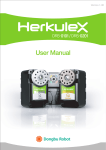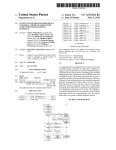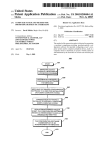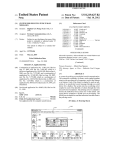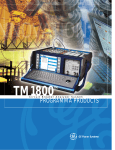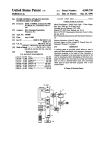Download Method and apparatus for managing the use of an electronic lock for
Transcript
United States Patent [191 [11] Patent Number: 4,724,537 Monet [45] Date of Patent: Feb. 9, 1988 [54] METHOD AND APPARATUS FOR [56] References Cited MANAGING THE USE OF AN ELECTRONIC LOCK FOR A MOBILE RADIO TELEPHONE [751 Invento? Paul L- Monet, Syracuse, N ‘Y. _ _ [73] Assigneez U'S' PATENT DOCUMENTS 7/1978 4,436,957 3/1984 Mazza et a1. Murray ........................... .. 179/90 D .. 179/2 EA 4,532,507 7/1985 Edson et al. ................. .. 340/s2s.31 0 Primary Examiner—Robert Lev Hams Corporation, Melbourne, Fla. Attorney’ Agent’ 0,. Fl-,.m_L_ Lawton Rogers, 111; Joseph M. Killeen [57] ABSTRAC'I‘I [21] Appl. No.: 651,711 _ [22] Bled‘ 4,099,033 A method and apparatus for managing an electronic Sep' 18’ 1984 radio telephone lock in which the electronic lock can be rendered operative or inoperative only by ?rst entering [51] [52] Int. Cl.4 ............................................ .. H04M 1/66 US, Cl. ............................ .. 379/58; 379/63 a predetermined code so as to prevent unauthorized use as well as accidental or unauthorized locking, code [58] Field of Search ............... .. 179/2 E, 2 EC, 90 D, changes, etc 179/2 CA, 18 DA, 2 A, 2 DP; 340/825.3l; 379/58, 66, 59, 60, 63 6 Claims, 1 Drawing Figure [16 MEMORY 18'“ /\ l4 DISPLAY l T i CONTROL [3 [:1 [j CIRCUIT TONE 5 ‘GENERATOR '“ El El E1 /~IO '2 El E1 E1 KEYPAD D ~< 22 240 Q / TRANS / MITTER 20/ I 30 28'-\ 24b 26 GP RECEIVER US. Patent Feb. 9, 1988 4,724,537 4,724,537 1 2 METHOD AND APPARATUS FOR MANAGING THE USE OF AN ELECTRONIC LOCK FOR A MOBILE RADIO TELEPHONE the dialing signals necessary to establish communication between the telephone instrument and the telephone network. Frequently, such electronic locks may be unlocked by performing an unlocking sequence consist ing of entering an unlock code comprising a predeter BACKGROUND OF THE INVENTION The present invention relates to a method and appara mined code sequence. If the correct code sequence is input, the control circuit removes the inhibit and ena tus for managing the electronic lock of a radio tele phone. More particularly, it relates to a method and apparatus for preventing the unauthorized use of the bles the transmission of the dialing signals. Electronic locks for telephone instruments of this type are dis“ telephone as well as the inadvertent or intentional tam July 4, 1978; U.S. Pat. No. 4,314,108 issued to Shauvit on Feb. 2, 1982; and United Kingdom Patent Applica tion No. 2,086,188 by Feuell ?led May 6, 1982. closed in U.S. Pat. No. 4,099,033 issued to Murray on pering with the electronic locking device. Subscribers to telephone service are often charged by the operator of the telephone system for each minute that the telephone is in use, and additional fees per min ute of use may also be charged for “long distance” calls. This is particularly true for special purpose telephones If a lock is accidentally locked, or tampered with, an authorized user of the mobile telephone who does not know the unlocking sequence will be denied use of the telephone. Additionally, an authorized user who mis such as mobile radio telephones. Accordingly, it is often important to limit operational access of unauthorized takenly believes that he knows the unlocking sequence may intentionally activate the locking mechanism and persons to a telephone. , 20 The nature of the use of telephones and particularly of mobile radio telephones is such that rigorous control of access to the telephone instrument is dif?cult to en sure. Often, the goal of limiting access to unauthorized henceforth be unable to unlock the system, possibly at the expense of an expensive service call to open the instrument for the purpose of reprogramming the look ing sequence. It is therefore an object of the present invention to personnel is in direct con?ict with a goal of allowing 25 obviate these and other problems in known electronic ease of access to authorized personnel. For example, mobile telephones are often installed in automobiles to permit use of the telephone system while driving. How ever, the authorized user of the telephone is frequently not the only person with access to the automobile. Park 30 ing attendants, automobile service personnel and per sons borrowing an automobile generally have to be given access to the interior compartment of an automo bile and thus have access to a mobile telephone located locking systems and to provide a novel method and apparatus for managing the use of an electronic lock, particularly for mobile radio telephones. It is another object of the present invention to pro vide a novel method and apparatus for controlling the use of telephone instruments without the use of a key. It is yet another object of the present invention to provide a novel method and apparatus for ensuring the therein. Likewise, land based telephones must fre 35 correctness of the unlocking sequence prior to engaging an electronic lock. quently be placed in locations where rigorous control of These and many other objects and advantages of the access to the dialing apparatus of such telephones is present invention will be apparent to one skilled in the dif?cult to achieve. A telephone installed in a public area may be convenient for authorized users but, at the same time, is accessible to unauthorized persons. The use of both physical and electronic locks to con trol the use of telephones is well known. Physical locks, which conventionally are engaged and disengaged by means of a key or combination, mechanically impede a would-be user from obtaining access to a portion of the art from the claims when read in conjunction with the appended drawing. DRAWING FIG. 1 is a functional block diagram of an embodi ment of the apparatus of the present invention. be locked by activation of a single switch or button and are unlocked by the execution of the correct unlocking DETAILED DESCRIPTION OF A PREFERRED EMBODIMENT One embodiment of the electronic locking system of the present invention is illustrated in a mobile telephone instrument in FIG. 1. In the figure, an input device such as a keypad 10 provides input signals to a control circuit 12. The keypad 10 contains a plurality of keys, some of which represent commands and others of which repre sent the digits 0 through 9 in a standard telephone in strument keypad. To assist a telephone user, a display 14 is provided to echo commands and digits entered on the keypad 10. The control circuit 12 communicates with a telephone instrument necessary for dialing. Telephone systems which utilize a key or other physi~ cal device to lock and unlock the telephone instrument require the telephone user to carry the key whenever use of the telephone is desired. An authorized user of a telephone who, for Whatever reason, does not have the unlocking key in his possession is denied the ability to place telephone calls. Electronic lock systems generally obviate the need for carrying a key because such systems generally can sequence. Other known electronic locks automatically storage device 16 and controls the operation of dialing lock the controlled device after each use. However, such electronic systems can often be accidentally locked or locked by unauthorized persons, by the mere signals from a dialing signal generator 18 to a transmit ter 20. The audio signals to be transmitted by the tele phone instrument are received by a microphone 22 and activation of a simple locking switch without any are converted to electrical signals which are passed to knowledge of the operating code. the transmitter 20 through one portion of a ganged Electronic locks are known in which telephone dial switch 24. Similarly, electrical signals representative of ing may be inhibited by the activation of a switch or 65 audio signals are received by the telephone instrument button on the telephone instrument. When the locking through an antenna 26 to a receiver 28 and subsequently button or switch is activated, the control circuits in the to a speaker 30. The speaker 30 converts the electrical telephone instrument inhibit dialing by not transmitting signals into audio signals. The electrical connection 3 4,724,537 4 via the other portion of the ganged switch 24. Addition ally, signals received by the receiver 28 are passed di the microphone 22 and the transmitter 20 and between the receiver 28 and the speaker 30. From the foregoing, it will be apparent that the pres rectly to the control circuit 12 so that incoming tele phone calls may be detected and‘announced. the use of a mobile telephone. Only authorized users can between the receiver 28 and the speaker 30 is switched ent invention provides unique management control of operate the lock, and can do so without a physical key. Moreover, the use of a single code sequence for both If a user wishes to place a call on the telephone instru ment which is enabled or unlocked, the user depresses appropriate keys on keypad 10 to indicate that a call is to be placed and the telephone number which the user locking and unlocking reduces the possibility of confu desires to call. Upon receipt of the signal from the key sion between the locking and unlocking codes and lapses of memory. Requiring that the code sequence be pad 10, the control circuit 12 performs a standard com= input before locking eliminates the possibility of inad= vertent locking by an error or mistake in the code semunications repertoire ?rst to obtain an available trans“ quence. Tampering is also inhibited. mission channel from a base station and second to send These and many other advantages of the present the appropriate tone signals from the dialing signal generator 18 to the antenna 26 through the transmitter 15 invention will be obvious to one skilled in the art from the claims. It should be understood that the foregoing 20 in order to signal the base station of the telephone number of the telephone being called. To complete the description of the preferred embodiment is illustrative audio circuit which enables the user to transmit his only, and that many modi?cations may be made with out departing from the spirit thereof as de?ned in the voice signal and hear the incoming signal, the control circuit 14 closes ganged switch 24, connecting the mi the speaker 30. claims when accorded a full range of equivalents. What is claimed is: 1. A method of managing the use of a mobile radio Subsequently, when the telephone call or calls are completed and the user desires to inhibit any further telephone comprising the steps of: (a) providing a mobile radio telephone having a plu crophone 22 to the transmitter 20 and the receiver 28 to telephone dialing by unauthorized persons, the user depresses certain keys of the keypad 10 which corre 25 spond to the unlock sequence and indicates to the con trol circuit 14 via one of the keys of the keypad 10 that he desires the telephone be locked. Upon receiving the unlock sequence and the lock command, the control 30 circuit 12 compares the unlock sequence to a sequence previously stored in the storage device 16. If the unlock sequence received from the keypad 10 matches the sequence stored in the storage device 16, the control circuit 14 disables the telephone instrument by opening rality of input keys; (b) providing an electronic lock responsive to the successive operation of a predetermined sequence of said keys to lock and unlock the telephone; (c) requiring entry of the predetermined sequence of keys prior to unlocking the telephone; and (d) requiring entry of the predetermined sequence of keys prior to locking the telephone; whereby both unauthorized use and inadvertent or un 35 the ganged switch 24. If the unlock sequence received from the keypad 10 does not match the sequence stored in the storage device 16, the control circuit 12 ignores the lock command and provides an indication on dis play 14 that the telephone instrument is still unlocked. The unlock sequence which both locks and unlocks the telephone instrument may be a predetermined se authorized locking of the telephone may be achieved without a physical key. 2. A method of managing the use of a mobile radio telephone comprising the steps of: (a) providing a mobile radio telephone; (b) providing an electronic lock responsive to a single predetermined code sequence; (0) requiring entry of the code sequence as a condi tion precedent to the enabling of the telephone; and quence of input signals from the keypad 10. Although described above as preceding the input signal indicating (d) requiring entry of the code sequence as a condi-: tion precedent to the disabling of the telephone, a lock command, the unlock sequence may also be en 45 whereby both unauthorized use and inadvertent or un tered after the lock command or both before and after authorized disabling of the telephone may be achieved without a physical key. the entry of the lock command. Indeed, the lock com 3. A method of preventing unauthorized use of an mand may be eliminated entirely if an unambiguous electronic lock comprising the steps of: unlocking sequence is selected. providing an electronic lock responsive to a plurality Whenever the telephone instrument is in the un locked state, it is possible to change the unlock sequence by either activating a code change switch on the keypad 10 or by operating a second code sequence indicative of a code change command. Upon receiving the code of preselected electronic signals in a preselected sequence for opening said lock; opening said lock by applying said plurality of prese lected electronic signals in said preselected se change command, the control circuit 12 will accept and 55 quence; and store in the storage device 16 the new lock sequence. While the memory storage device 16 has been hereto fore described as an electronic storage device, the pres ent invention does not so require, and the storage device may be any method of indicating a code sequence to the closing said lock only upon the receipt by said lock of said plurality of preselected electronic signals in control circuit 14, e.g., coding plugs for grounding sequence. 4. A security device for a telephone instrument com said preselected sequence, so that said lock cannot be closed except by persons knowing said plurality of preselected electronic signals in said preselected certain wires attached to the control circuit 12 and indicative of a coding sequence. The control circuit 12 may be designed to inhibit all calls (both incoming and outgoing), inhibit outgoing calls, or inhibit incoming calls only, because the control circuit 12 controls both the dialing signal generator 18 and the switch 24 to the communication paths between prising: selectively operable inhibit means to prevent the use 65 of said instrument; signal recognition means operable to receive a plural ity of signals representing a predetermined code; and 5 4,724,537 control means, responsive to said signal recognition 6 6. In an electronic lock for a telephone having an‘ input means providing a plurality of different signals, each signal representing’ an input signal from a user, a memory means for storing a plurality of memory sig nals, each said memory signal representing at least one of said input signals and a control means for selectively inhibiting operation of the telephone, a method of pre venting accidental or unauthorized operation of said control means comprising the steps of: means, to operate said inhibit means and to disable said inhibit means only upon the receipt of said predetermined code. 5. An electronic lock device to prevent unauthorized use of a telephone instrument, comprising: digital input means for the receipt of input signals from a user of said instrument; locking means operative to selectively prevent use of said instrument; logic means responsive to said digital input means and controlling said locking means, said logic means enabling said locking means upon the receipt of a 10 receiving a predetermined plurality of input signals; comparing said plurality of input signals with said plurality of memory signals; and operating said control means only if each of said plurality of input signals matches said plurality of predetermined sequence of input signals by said digital input means and disabling said locking 5 memory signals, thereby to prevent persons not knowing the plurality of memory signals from op erating said lock. means upon the receipt of said predetermined se quence of input signals. * 25 30 35 45 55 60 65 * * * * UNITED STATES PATENT AND TRADEMARK OFFICE CERTIFICATE OF CORRECTION PATENTNO. DATED 14,724,537 : INVENTOFKS) : February 9, 1988 Paul L. Monet It is certified that error appears in the above-indentified patent and that said Letters Patent is hereby correcied as shown below: Column 8‘, lines 20, 28, 3S, and 61, for the drawing reference numeral "in", each occurrance,should read ——12—-. ' Signed and Sealed this First Day of July, 1997 Arrest: 6M 2 ‘ BRUCE LEHMAN Arresting O?icer Commissioner of Parents and Trademarks US004724537C1 (12) EX PARTE REEXAMINATION CERTIFICATE (4926th) United States Patent (10) Number: US 4,724,537 (:1 Monet (45) Certi?cate Issued: Harris Corp., RF Communications Group, Mobile Tele (54) METHOD AND APPARATUS FOR phone Division, “Cellular Mobile Telephone Operator’s MANAGING THE USE OF AN ELECTRONIC LOCK FOR A MOBILE RADIO TELEPHONE Instruction Manual,” Alpha Custom, pp. 1—56 and A1—A4 (2/85). (75) Inventor: Paul L. Monet, Syracuse, NY (US) (73) Assignee: Harris Corporation, Melbourne, FL Harris Corp., RF Communications Group, “Mobile Tele phone Operator’s Instruction Manual,” Alpha E/EI pp. (Us) 1—36 and A1—A2 (3/84). Harris Corp., RF Communications Group, “Mobile Tele Reexamination Request: phone Operator’s Instruction Manual,” Alpha 40, pp. 1—19 (1982) and Addendum No. AD—6624—1404(4/88). No. 90/005,578, Dec. 1, 1999 Reexamination Certi?cate for: Patent No.: Issued: 4,724,537 Feb. 9, 1988 Appl. No.: Filed: 06/651,711 Sep. 18, 1984 “Motorola DYNA T.A.C 6000X Universal Mobile Tele phone,” Product Brochure, pp. 1—5. “DYNA T.A.C Cellular Mobile Telephone General Descrip tion,” Technical Writing Services, Schaumburg, IL, Jun. 15, 1983, pp. 1—3. “Operating Instructions for the Emerald Radiophone”, Brit ish Telecom Radiophone, 4 pages. “Operating Instruction for the Sapphire Radiophone”, Brit ish Telecom Radiophone, 4 Pages. British Telecom Time Line Chart, 1 Page. “Radiophone No Longer Just an Executive Toy,” Telecom, Feb. 1984, p. 5. Extra Features Make Sapphire a Gem, Telecom, Mar. 1984, Certi?cate of Correction issued Jul. 1, 1997. (51) Int. Cl.7 ............................................... .. H04M 1/66 (52) US. Cl. ..................................................... .. 455/565 (56) References Cited U.S. PATENT DOCUMENTS 3,508,202 A 4/1970 Joel, Jr. .................... .. 340/164 3,958,231 A 5/1976 Hoffman 4,114,147 A 4,510,623 A 9/1978 Hile ............... .. 340/528 4/1985 Bonneau et a1. .......... .. 455/181 340/274 p. 4. FOREIGN PATENT DOCUMENTS JP JP Apr. 13, 2004 46-62189 54-91242 “Stornomatic 900 User Instructions,” Storno Radio Com munications Systems, 7 Pages. “Televa Cargo Ammattilaisen NMT—Autopuhelin,” Adver tisement, 1 Page. “Quattro Keyboard Buttons and Indicators,” Communica tions Systems, 1983, 1 Page. 4/1973 2/1981 OTHER PUBLICATIONS Motorola Communications and Electronics Inc., “DYNA T.A.C. 8000X Cellular Portable Telephone User’s Manual,” pp. 1—50 (Feb. 20, 1984). Motorola, Southwest NeWsWire Press Release dated Mar. Primary Examiner—Lee Nguyen 13, 1984 regarding “Motorola Announces Complete New CellularPortable and Mobile Telephone ProductLineAvail (57) ABSTRACT able Now”, pp. 1—3. Mortorola, NeWsWire Press Release dated Mar. 13, 1984 regarding “Motorola ’s communication sector Introduces the A method and apparatus for managing an electronic radio telephone lock in Which the electronic lock can be rendered most complete and comprehensive line of cellular portable and mobile telephones available in the industry today.” pp. mined code so as to prevent unauthorized use as Well as 1—3. accidental or unauthorized locking, code changes, etc. operative or inoperative only by ?rst entering a predeter rl6 MEMO RY .8 l I4 TONE GENERATOR CONTROL U U E! CIRCUIT E] 1:: :1 /IO ’\ '2 El :1 El KEYPAD 22 240 C TRANS MITTER 2O 28 '\ $50 24b C RECEIVER US 4,724,537 Cl 1 2 EX PARTE AS A RESULT OF REEXAMINATION, IT HAS BEEN REEXAMINATION CERTIFICATE ISSUED UNDER 35 U.S.C. 307 DETERMINED TEATI Claims 1—5 and 6 are cancelled. THE PATENT IS HEREBY AMENDED AS INDICATED BELOW. * * * * *








